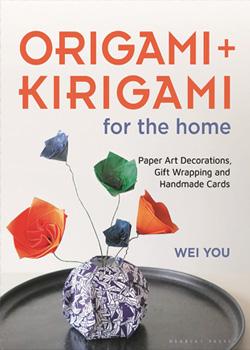Origami and Kirigami for the Home

By Wei You
Herbert Press (2022)
ISBN-13: 978-1789940824
Review by Tung Ken Lam
This attractive book by author Wei You shows you how to make paper objects for practical and display purposes around the home. Kirigami - a variation of origami in which the paper is also cut as well as being folded - is second main word of the title, so origami ‘purity’ (i.e., achieving results by folding alone) is not a priority and all of the following are encouraged: cutting, decorating, glueing, mounting on wires, etc.
This review considers several criteria and, with some important reservations, Wei You’s book succeeds in all of them. In the first place, regarding the overall look and feel, this is an attractive book with full colour images throughout. Moreover, in relation to the content of the book, the projects are enjoyable to make and there is enough variety and interest. In addition to origami decorations and items to display, 35 pages are devoted to gift wrapping and greeting cards with a good representation of the different genres of papercraft, folding and cutting.
Another criteria to consider is if the instructions that are clear and easy-to-follow. In this regard, this book uses a sensible mix of diagrams and photo-diagrams. The origami projects use diagrams drawn on a computer, a good decision as diagrams are usually better than photographs for showing what’s important when folding. Photos are used later in the book for projects like gift wrapping and projects involving cutting and glueing. Near-standard origami symbols are used, but curiously the “push-in” symbol only seems appears in the double-page spread of basic folds. Some steps have errors in the diagrams, for instance, the step 5 at page 53 has only valley fold lines for an inside reverse fold (mountain fold lines and push-in arrows would be correct). Some diagrams omit folding arrows when they would help the reader, for example in the lower half at page 39.
A more important problem is that the illustrations for the steps in the origami diagrams are too small and often cramped, as in page 46 with almost 30 steps. Even when there are fewer steps, the steps are still small – page 36 has steps that are only 15 mm wide. The basic crane in page 83 has 12 steps yet there is empty space 4 cm tall at the top and bottom of the page. I admit that I myself have used illustrations this small, but this book has pages four times the size of my book.
One way of making more space would have been to refer to the basic folds instead of repeating instructions on how to make the preliminary fold (square base) and bird base in each project that uses it (hinode crane, p. 32; hakobu crane, p. 36; geometric base, p. 38; flamboyant flamingo, p. 44; square flower tiles, p. 76; crane, p. 83).
My fourth criteria to review focuses on how much the book relies on special and decorated paper and if the projects could work using ordinary plain paper. In Wei You’s book, copy paper is recommended as an economical source, although fancy paper is mentioned too. Curiously, no explanation of grams per square metre is given.
Finally, I have considered the voice of the author and if they encourage creativity and suggest other paths and sources to follow up. In this regard, this book does not include any credits for the creators of the models. To be fair, some are traditional, and others are direct applications of standard papercraft techniques. However, despite the author’s stated scientific background and interest in geometric origami (p. 159), opportunities have been missed to note, let alone explain, some accessible origami geometry, for example dividing an edge into thirds (p. 57), folding a 60° angle (p. 25) and approximating a regular pentagon (p. 21).
As seems standard with modern books, this book lacks an index. Another standard is the author directing the reader to her video tutorials (her YouTube channel has a playlist for the book that is not accessible without scanning the QR codes in the book). Another missed opportunity is to recommend other resources such as books, websites and origami societies to help the reader to build up their knowledge and connect with other people. For example, origami purists may prefer books in English such as Home Decorating with Origami, by Tomoko Fuse (2000), Origami for Parties, by Kazuo Koboyashi and Makoto Yamaguchi (1987), Origami for Displays, by Florence Temko (1974), and Paper Home: Beautifully unique origami projects, by Esther Thorpe (2016). For general papercraft, there are similar publications such as The Ultimate Papercraft and Origami Book, by Paul Jackson and Angela A’Court (1997) or Paper Only: 20 Ways to Kick-Start Your Creativity, by The Papered Parlour (2014).
Overall, despite some problems with the diagrams, Origami and Kirigami for the Home may be the best bet for its combination of diagrams and videos, and for the variety of papercrafts used in its projects.

